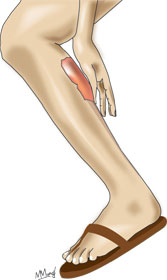Leg cramps are common, but often their cause is not known. However, some medicines and some medical conditions can sometimes cause leg cramps.
What is a leg cramp?
A leg cramp is a pain that comes from a muscle in the leg. It occurs due to a muscle spasm which is when a muscle contracts too hard. It usually occurs in one of the calf muscles, below and behind a knee. The small muscles of the feet are sometimes affected too.
A cramp pain typically lasts a few minutes. In some cases it lasts just seconds, but some times it can last up to 10 minutes. The severity of the pain varies. The muscle may remain tender for up to 24 hours after a leg cramp.
Leg cramps usually occur when you are resting - most commonly at night when in bed. (They are often called night cramps.) They may wake you from sleep and can become a distressing condition if your sleep is regularly disturbed.
Who gets it?
Many people have an occasional leg cramp. However, they occur frequently in some people, more commonly in older folk. About 1 in 3 people over the age of 60, and about half of people over the age of 80 have regular leg cramps. About 4 in 10 people who have leg cramps have at least three per week. They occur every day in some cases.
What causes it?
Unknown cause (idiopathic leg cramps)
In most cases the cause is not known. One theory is that cramps occur when a muscle that is already in a shortened position is stimulated to contract. As the muscle is already shortened, to contract further may cause the muscle to go into spasm. This commonly happens at night in bed as the natural position we lie in is with the knees slightly bent (flexed), and with feet pointing slightly downwards. In this position the calf muscle is relatively shortened and prone to cramps. This theory explains why stretching exercises may cure the problem.
Secondary causes
In some cases, the cramps may be a symptom of another condition or problem. For example:
- Some medicines can cause cramps as a side-effect, or make cramps occur more often. These include: diuretics ('water tablets'), nifedipine, cimetidine, salbutamol, terbutaline, lithium, clofibrate, penicillamine, morphine (withdrawal), phenothiazines, and nicotinic acid.
- Over-exertion of muscles.
- Dehydration.
- Conditions that cause alterations in the balance of salts in the bloodstream (such as a high or low sodium or potassium level).
- Some people who have renal (kidney) dialysis get leg cramps.
- Pregnancy - usually in the later stages.
- An untreated under-active thyroid gland.
- Peripheral vascular disease (narrowing of the leg arteries which causes poor circulation).
- Cirrhosis of the liver is a rare cause.
- Lead poisoning
- Sarcoidosis
- Rare disorders of nerves
- Excess alcohol.
With the above conditions the cramps would just be one of various other symptoms. Therefore, if you are otherwise well, and have no other unexplained symptoms, then the leg cramps are likely to be idiopathic (unknown cause) and not due to a secondary cause.
What is the treatment?
Stretching and massaging the affected muscle (usually a calf muscle) can usually relieve an attack of cramp. Most cramps soon ease off. Painkillers are not usually helpful for a sudden attack of cramp. However, a painkiller such as paracetamol may help to ease muscle discomfort and tenderness that sometimes persists for up to 24 hours after a cramp has gone.
How to prevent it?
If cramps do not occur often, then no particular treatment is usually needed. However, if you have frequent cramps, you may wish to consider ways of preventing them.
- Consider your medication (where appropriate) or other conditions
- Tell your doctor if you take any of the medicines listed above. It may be causing the leg cramps, or making them recur. Alternative medicines may be available. Also, if you have other symptoms apart from cramps, see your doctor who may check to rule out a secondary cause for the cramps.
Stretching exercises
Stretching exercises are commonly advised. At first, do stretching exercises of affected muscles for about five minutes, three times a day. Do the last exercise shortly before bedtime. If the cramps ease, you may then only need to do the exercise once or twice a day to keep the cramps away.
To stretch calf muscles, stand about 60-90 cm from a wall. Then, keeping the soles of your feet flat on the floor, bend forward and lean on the wall. You will feel your calf muscles stretch. Do this several times, each time for as long as you can manage.
Posture of the legs
when resting in bed
Certain positions which prevent the calf muscle from shortening when you are asleep may help. The following are not proven treatments (from research studies), but some experts believe that they help to prevent cramps.
- using a pillow to prop the feet up in bed while sleeping on your back.
- hanging the feet over the end of the bed while sleeping on your front.
- keeping blankets loose at the foot of the bed to prevent toes and feet from pointing downwards during sleep.
Quinine
Quinine tablets are a common treatment. Quinine often reduces the number and severity of leg cramps, but may not stop them altogether. One tablet at bedtime is the normal dose. A four week course is commonly tried at first and can be continued if the cramps reduce. It may be worth stopping the quinine tablets every three months or so to see if they are still needed.
Other treatments
Other suggested medicines include: naftidrofuryl, vitamin E, verapamil, diltiazem, painkillers, aspirin, orphenadrine, magnesium, calcium, and sodium chloride.
(The writer is Consultant Rheumatologist, Sri Jayewardenepura General Hospital) |

